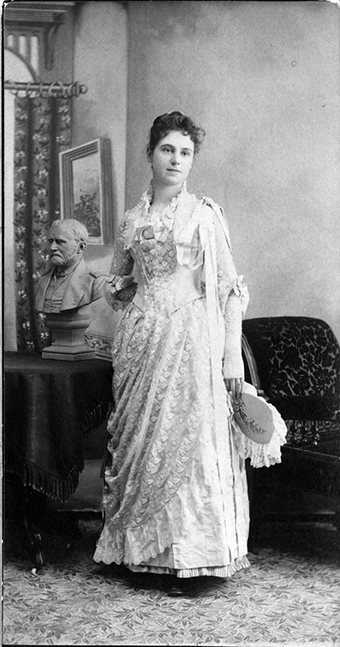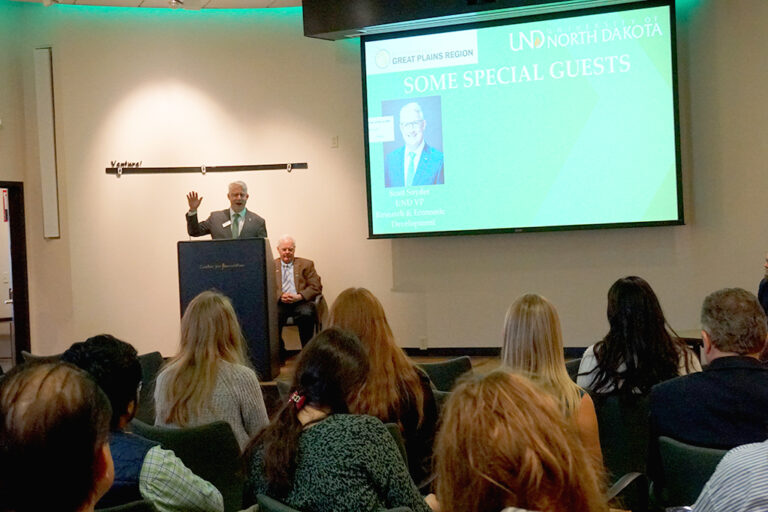UND’s unforgettable Dr. Cora Smith Eaton King, Class of 1889
Smith Hall’s namesake planted ‘Votes for Women’ flags in nation’s consciousness – and atop Mt. Rainier

Physician. Surgeon. Teacher. Elocutionist. Mountaineer. Activist. Suffragist. Dr. Cora Smith lived an unconventional life, and her work advocating votes for women is still remembered a century later.
A member of UND’s first graduating class in 1889, Cora Smith, who was born in 1867, taught at the newly formed University of North Dakota while still a student, and continued teaching after her graduation. Famed for her speaking abilities, she went on to become the first licensed woman physician in North Dakota. Most of all, she is remembered for her work in advocating voting rights for women. On campus, Smith Hall bears her name.
Dr. Cora Smith Eaton King was the topic of this year’s Wilkins Lecture, which is organized by the UND Department of History and American Indian Studies and named for longtime history professor Robert P. Wilkins, who served at UND from 1945 to 1991. The talk was introduced by Cynthia Prescott, professor of history.
“In the Thickest of the Fray: Cora Smith Eaton and the Struggle for Woman Suffrage in North Dakota” was presented by Kristin Mapel Bloomberg, Hamline University professor of women’s studies and endowed chair in the humanities, Thursday afternoon over Zoom.
The talk was preceded by the virtual dedication of the National Votes for Women Trail Marker on the grounds of the Grand Forks County Courthouse. It commemorates the 100th anniversary of the 19th Amendment, which gave women the right to vote.
An unconventional life
Cora Smith was indeed in the thickest of the fray, said Bloomberg, whose extensive research on Cora Smith Eaton King appears in Equality at the Ballot Box: Votes for Women on the Northern Great Plains.

“Cora Smith Eaton King’s impact on the American woman suffrage movement was profound,” Bloomberg said. “Her time in North Dakota was formative, and her suffrage work in the state allowed her to develop skills as a speaker, writer, collaborator, and political strategist, which she applied to her many accomplishments.”
Throughout her life, Cora Smith Eaton King advocated for women’s voting rights while forging a career as a physician. She and her mother, Sara Smith, were the first women to vote in Grand Forks in 1890.
As Dakota Territory began its transition to statehood, the topics of prohibition and suffrage loomed large. In the spring of 1888, Cora and Sara organized the Grand Forks Woman Suffrage Association, the first such group in what is now North Dakota. Cora served as secretary, and Sara was elected president of the organization.
In the spring of 1889, Cora was a member of the first class to graduate from UND, and later studied medicine at Boston University. That summer, during the North Dakota Constitutional Convention, Henry Blackwell, a national suffrage advocate, addressed the constitutional convention, and chose Cora as his advocate. A popular orator as well as a regional celebrity, she lobbied the convention.
Victory was marginal. The issue of suffrage was fiercely debated, and on the 43rd day of the convention, women were given the right to vote in school matters if they met certain qualifications. However, they were not allowed to vote for governor or other offices, and a dilemma arose about how to limit women to voting only for school matters.
The solution became a separate ballot box for women, which caused other problems.
In October 1889, the North Dakota Constitution was approved, and North Dakota was the first state to enter the Union under Prohibition. School suffrage was approved, but women had no other voting rights.
First women to vote

In 1890, Cora and Sara Smith became the first women to vote in Grand Forks in a school election. To solve the “problem” of women possibly voting for other offices, the state required separate ballot boxes for women, and each judge decided for himself how to handle women’s votes. In some cases, a cigar box with a hole in the lid was used for women’s votes. Some women’s votes were “lost,” and some weren’t counted at all.
Because of the confusion regarding separate ballot boxes for women voters, during the next five years, some North Dakota women were barred from voting, and in 1893, the Third Legislative Assembly finally passed a woman suffrage bill that provided women extended voting access. However, the bill was “lost” on the way to the governor’s desk for signing. North Dakota women achieved the ability to vote for all elected offices when the 19th Amendment to the U.S. Constitution was passed in 1920.
Lifetime of suffrage
Cora Smith Eaton, however, was undeterred despite setbacks, and continued to advocate for suffrage despite resistance. In 1895, Smith Eaton, now a physician in Grand Forks who continued to teach at UND, was elected the first president of the North Dakota Equal Suffrage Association, and Sara served as corresponding secretary.
Smith Eaton moved to Minnesota in 1896 to take a position at the Maternity Hospital in Minneapolis. About that same time, a scandal enveloped her husband, Robert Eaton, a lawyer who was disbarred. The couple separated, and divorced in 1906.
Even though she was a physician for the Minneapolis Maternity Hospital, Cora continued as president of the North Dakota Suffrage Association, and to advocate for suffrage both in North Dakota and Minnesota. In 1897, the group disbanded.
She moved to Seattle and built a medical practice. There, she became involved in the Washington state suffrage movement, as well as mountaineering. In 1909, she planted a “Votes for Women” flag on top of Mount Rainier.
She married Judson King in 1912, and moved to Washington, D.C., built another successful medical practice, and continued her advocacy for women’s rights. The couple later divorced, and she moved to California in 1924, establishing another medical practice. She died there in 1939.
“Throughout her life, she was definitely in the thickest of the fray,” said Bloomberg. “Had she remained in North Dakota, the state might have earned its star on the national suffrage flag.”


